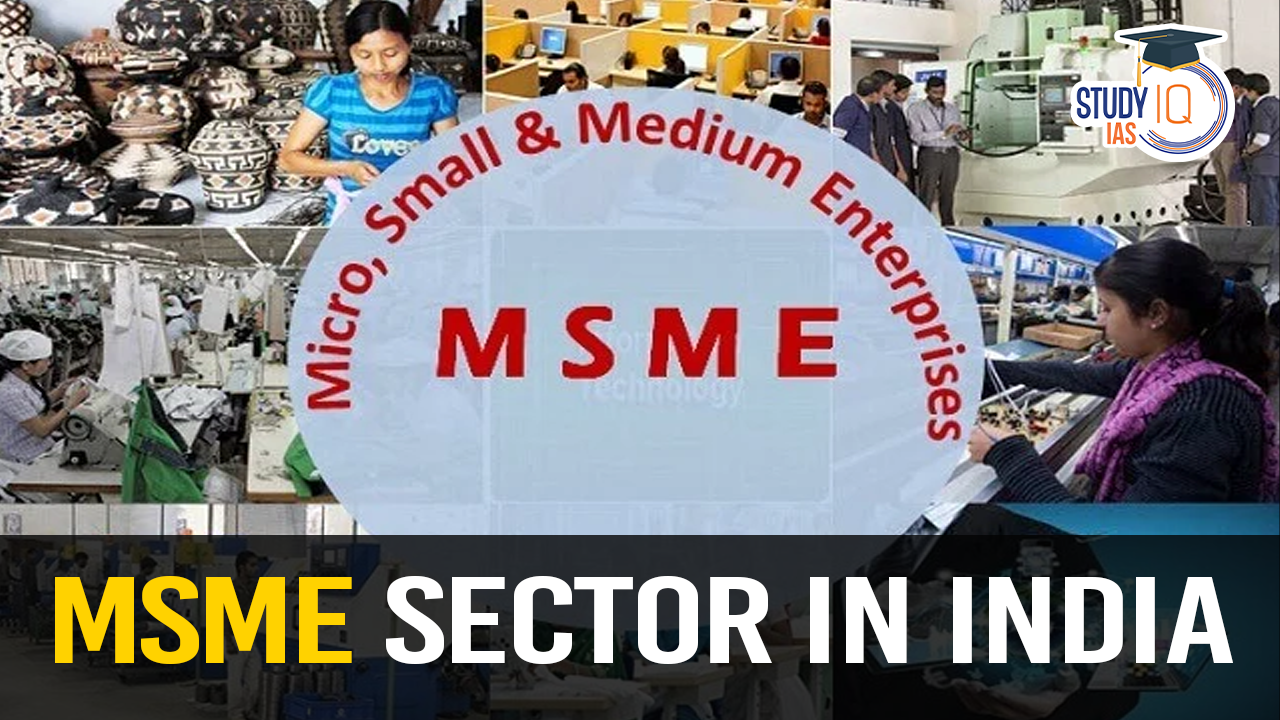Table of Contents
Context: The Union Ministry of Micro, Small, and Medium Enterprises (MSME) is amending the MSME Development Act, 2006 to improve mechanisms for managing disputes related to delayed payments and better to address the evolving needs of the MSME sector.
More in News
The MSME ministry is also in the process of transforming the Samadhaan portal, which currently only tracks disputes arising from delayed payments to micro and small enterprises (MSEs), into a comprehensive online resolution platform.
Micro, Small, and Medium Enterprises (MSME)
- MSME stands for Micro, Small, and Medium Enterprises, which are businesses involved in the production, processing, and preservation of goods and commodities.
- Criteria: These enterprises are classified based on their investment in plant and machinery for manufacturing units or equipment for service sectors, as well as their annual turnover.
- Micro Enterprises: Investment in plant and machinery or equipment should not exceed Rs. 1 crore.
- Annual Turnover: Should not exceed Rs. 5 crore.
- Small Enterprises: Investment in plant and machinery or equipment should not exceed Rs. 10 crore.
- Annual Turnover: Should not exceed Rs. 50 crore.
- Medium Enterprises: Investment in plant and machinery or equipment should not exceed Rs. 50 crore.
- Annual Turnover: Should not exceed Rs. 250 crore.
- Micro Enterprises: Investment in plant and machinery or equipment should not exceed Rs. 1 crore.

MSME Regulation and Support in India
- Ministerial Oversight: In 2007, the Ministry of Small Scale Industries and the Ministry of Agro and Rural Industries were consolidated into the Ministry of Micro, Small, and Medium Enterprises.
- Role of the Ministry: This ministry is responsible for developing policies, facilitating programs, and monitoring their implementation to support the growth and development of MSMEs.
- Legislative Framework: The Micro, Small, and Medium Enterprises Development Act of 2006 was enacted to address issues affecting MSMEs, establish a National Board for MSMEs, define what constitutes an “enterprise,” and empower the Central Government to boost MSME competitiveness.
| Facts Related to MSMEs |
|
Key Government Initiatives for MSMEs in India
- Pradhan Mantri MUDRA Yojana (PMMY): Offers loans up to ₹10 lakh for non-corporate, non-farm small/micro enterprises, categorised under MUDRA loans.
- Credit Guarantee Schemes: Managed by the Credit Guarantee Fund Trust for Micro and Small Enterprises (CGTMSE), these schemes help reduce the risk for lenders, thereby facilitating easier credit access for MSMEs.
- MSME SAMADHAAN: An online platform serving as a Delayed Payment Monitoring System, overseen by the Micro and Small Enterprise Facilitation Council. It aids MSMEs in resolving disputes related to delayed payments, enabling them to file cases and track their status online.
- Government e-Marketplace (GeM): An online portal that assists MSMEs in accessing broader markets by facilitating public procurement from these enterprises.
- Udyam Registration: A streamlined online registration process that enables MSMEs to benefit from various government schemes and support.
- CHAMPIONS Portal: An ICT-driven platform that functions as both a Control Room and Management Information System. It is designed to boost the efficiency, output, and national strength of Indian MSMEs by helping them resolve issues, providing guidance, and supporting their development into national and global leaders in their sectors.
Stats IQ: The Indian MSME Sector
- It is estimated that there are 633.9 lakh MSMEs in India.
- The Micro sector includes 630.5 lakh enterprises, accounting for over 99% of the country’s total number of MSMEs.
- The Small sector includes 3.3 lakh enterprises (0.5% of total MSMEs), while the Medium sector includes 0.05 lakh enterprises (0.01% of total MSMEs).
- Around 324.9 lakh enterprises (52.3% of total MSMEs) are in rural areas, while 309 lakh enterprises (48.8%) are in urban areas.
Benefits of the MSME Sector to the Indian Economy
- MSME Sector’s Contribution to Indian Economy: As per the Ministry of Statistics & Programme Implementation, the contribution of the MSME sector to the Gross Value Added (GVA) in the country’s GDP in FY 20 was 30%. The share has been around 30% over the past few years. The sector’s contribution to manufacturing in all India manufacturing gross value output in FY 20 stood at 36.9%, the same as that in FY 19.
- MSME Contribution to Export in India: The MSME sector is among the country’s major exporters. Specified MSME-related product exports accounted for 49.5% of India’s total exports in FY 21, compared to 49.8% in FY 20. Textiles, garments, different types of shoes, rice and castor oil are among the major products exported by the Indian MSME sector.
- Employment Generation: The MSME sector is one of the country’s major employers. The sector has been instrumental in generating employment opportunities in rural and remote areas of the country. As per the data from the Udyam Portal of the Ministry of MSMEs, 93,94,957 people were employed by MSMEs registered on the portal in FY 22.
- Connecting Remote Areas to Rest of the Country: By preparing key raw materials and finished goods with global demand, MSMEs in remote and backward areas help connect these areas with the rest of the country and the world. Several MSMEs operate in rural areas while providing ancillary goods to large multinational companies across the globe.
- Improving Standard of Living: By creating employment opportunities and connecting backward areas, the MSME industry in India plays a key role in lifting people out of poverty and improving their standard of living. Thus, the sector helps reduce regional imbalances across the country and increase equality among citizens.
Challenges faced by MSMEs in India
Finance
- Delayed payment: Four years after the MSME SAMADHAAN portal was set up to help enable faster payments and improved cash flows to India’s MSMEs, the number of applications filed for relief on the portal is piling up closer to one lakh.
- Credit gap: MSMEs still find access to formal credit a challenge. Roughly 40 per cent of MSME lending is done through the informal sector (in 2018), where interest rates are at least twice as high as in the formal market. The reason for the enormous credit gap is two-fold:
- Lack of assets among MSMEs such as land and buildings etc. to secure asset-based financing or secured loans.
- Credit risk assessment challenges faced by financial institutions owing to lack of financial data and credit history among small businesses.
Infrastructural bottlenecks
- Land: Due to the high cost of land, the circle rate of Industrial area is usually high making it unaffordable for the MSME entrepreneur.
- Power & water: Delay in getting access to power and water connection. Lack of adequate power supply in a few parts of the country.
- Logistics: Lack of a cost-effective and efficient logistics/supply chain infrastructure as well as lack of dedicated infrastructure i.e. ready-to-move-in, built-in factories with plug-and-play facilities.
- Poor infra for capacity building: Lack of access to R&D Centres, Product and Prototype Development Centres, Testing Laboratories, etc.
- Poor marketing strategy: MSMEs because of their size are unable to achieve economies of scale or hire a marketing specialist who can guide them to have a robust marketing strategy. Also, they do not have an adequate footprint on digital marketing platforms.
Access to Technology: Though India has a vast pool of technical talent with well-developed intellectual capability, the country still scores low in terms of developing, commercializing and adopting new and innovative technologies.
Women-specific issues: The number of women-led MSMEs in India has jumped from 2.15 lakh to 1.23 crore in just a decade. However, they face a financial gap of $158 billion and largely rely on informal sources. About 90 per cent of SMEs owned by women in the country still rely on informal ways of securing capital or loans. Besides, social attitudes and socioeconomic constraints also hold women back from becoming entrepreneurs.


 Donald Trump’s Reciprocal Tariffs: Imp...
Donald Trump’s Reciprocal Tariffs: Imp...
 Growth in Gold Loans and NPAs, Reasons a...
Growth in Gold Loans and NPAs, Reasons a...
 How RBI Responded To Global Trade War Ch...
How RBI Responded To Global Trade War Ch...





















